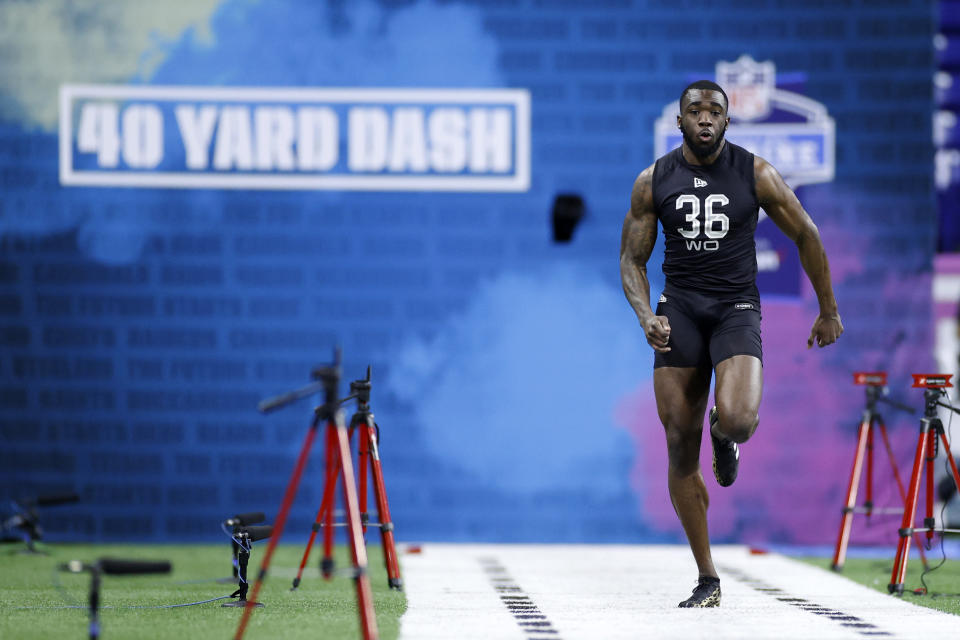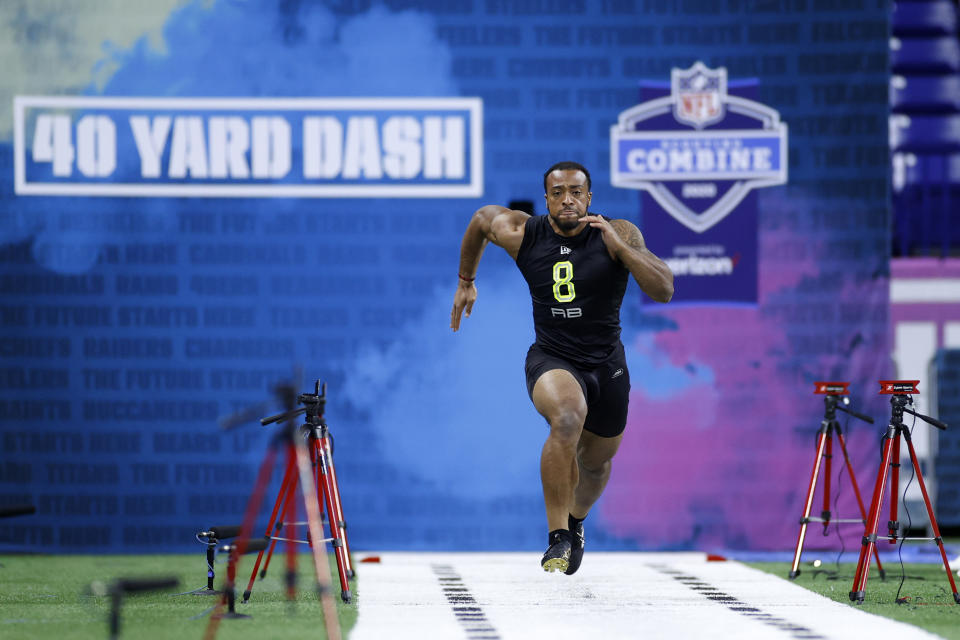Top 10 fantasy rookie takeaways from the 2020 NFL Combine

In 1982, when the NFL Scouting Combine was first established, the event’s aim was to collect medical data on the incoming rookie class. Over the past 38 years, the scope of the occasion has widened to include physical drills and psychological tests. Talent evaluation will never be perfect, but that’s not going to stop the league from tweaking (and televising) one of the offseason’s most discussed spectacles.
The data collected and conversations started are the first impressions of over 300 prospects. Undoubtedly, opinions will shift and narratives will evolve. But right now we’re at the beginning of these hopefuls’ journey to the next level. Here are my 10 takeaways from this year’s combine.
Combine confirms the depth of wide receiver talent
The 2020 class was rumored to be stacked with receiving talent, and the combine confirmed this is indeed the case. Quite a few wideouts moved up draft boards (as noted below), but CeeDee Lamb and Jerry Jeudy remain favorites to go in the first 15 spots of the 2020 NFL Draft. While neither posted a vert score above 35 inches or a stellar 40-yard-dash time (Lamb ran a 4.50 and Jeudy clocked in at 4.45), their hands were on full display in the end zone fade drill. Whether teams favor Lamb’s physicality or Jeudy’s polish, both WRs proved they’re pro-ready.
Henry Ruggs is NOT slow
Expectations for Ruggs were high heading into the week, as he was a favorite to challenge John Ross’ historic 40-yard-dash time (4.22 second). While he didn’t fly past the former Washington product, Ruggs was the fastest human in Indy, closing out the event with a time of 4.27 seconds. With that sort of speed, it’s no wonder that nearly a quarter of his career grabs have gone all the way. A YAC monster and proficient route-runner, Ruggs’ skillset would complement Courtland Sutton’s beautifully.
Denzel Mims — unicorn?
Plenty of receivers have size. Some have speed. Few have both. Denzel Mims, however, might just be a mythical combination of all the things. At 6-foot-3 and 207 pounds the Baylor product crushed the combine, managing a 40 time of 4.38 seconds (top-three among WRs), a vertical jump of 38.5 inches (top-ten among WRs), a broad jump of 131 inches (top-four among WRs), and a position-best time of 6.6 seconds in the three-cone drill. The 22 year old Texas native is far from a polished route-runner, but his catch radius in tandem with his testing profile has certainly sent his stock soaring.
Justin Jefferson finally got a glow up
Despite hauling in 18 scores throughout the 2019 season, the 21-year-old’s star has been overshadowed not only by his QB but also his fellow receiver, Ja’Marr Chase … who bested Jefferson by 2 scores. With Chase staying in Louisiana, Jefferson made a profound statement in Indianapolis. Already believed to be a versatile WR with advanced route-running prowess and natural hands Jefferson cleared up any questions about his long speed by running the 40 in 4.43 seconds (top-nine among wideouts). In doing so, he’ll likely come off the board in the first round of April’s draft. He projects to be a No. 2 receiver (a la, Tyler Boyd) at the next level, but a landing spot like New Orleans or even Buffalo could make him an interesting fantasy asset.
Jonathan Taylor is who we thought he’d be …
... Only better. A former track star, Taylor was expected to blaze in the 40-yard-dash — and he did. The fastest player at his position, the 226-pound Taylor clocked in at 4.39 seconds. That means his adjusted weight/speed score puts him in the 98th percentile among active running backs. Taylor didn’t stop there, however, putting together an impressive performance during the pass-catching drills. With only 26 catches over his final season at Wisconsin, it was imperative that Taylor prove his mettle as a three-down back. Mission accomplished (for now).
Cam Akers showed out
A five-star recruit out of high school, Cam Akers spent the last three years efforting behind a flimsy offensive line and within an inconsistent scheme. While he did manage to break Dalvin Cook’s freshman rushing record, the overall situation at Florida State limited the Mississippi native’s statistical ceiling. Akers, however, refused to be defined by his time in Tallahassee and showed out in Indy. Not only did he run the 40-yard-dash in 4.47 seconds (top-five) and manage 20 reps during the bench press (top-nine), but he also lit up the new Duce Staley drill.
[Yahoo Sportsbook powered by BetMGM: Deposit $10, Get $100 in Free Bets. NJ only. 21+. Terms apply]
A.J. Dillon is the answer to a question on an AP physics exam
Despite tipping the scales at 247 pounds, the BC alum led all participating running backs in the vertical and high jumps with respective scores of 41 and 131 inches. For reference, Dillon is the same height and seven pounds heavier than Leonard Fournette, yet managed to best Fournette’s vert score by more than a foot.

The New England native additionally posted top-ten numbers in the 40-yard dash (4.53 seconds), bench press (23 reps), and the 3-cone drill (7.19 seconds). Given Dillon’s size, athleticism, and skillset (a power runner who wins at the goal line, but lacks pass-catching experience) the Derrick Henry 2.0 #taeks will be in full-effect by April.
The tight end position is ever-changing
Converted wide receivers continue to redefine the boundaries of the tight end position. Adding ten pounds to his 6-foot-4 frame over the last month, Chase Claypool weighed in at 238 pounds … and was promptly asked to work out as a TE. The heaviest participating wideout in Indy, Claypool managed a top-seven 40 time (4.42 seconds), a top-four vertical jump score (40.5 inches), and top-five bench press finish (19 reps). Whether teams believe him to be the next Calvin Johnson or a burgeoning Darren Waller, he figures to be drafted (and deployed) with his athleticism in mind.
The projected No. 1 overall pick is not lacking in confidence
Joe Burrow’s hands may be the only small thing about him. The reigning National Champ didn’t work out in Indy, but he did make his presence known. From playfully clapping back on social media to reportedly acing his team interviews, Burrow exuded the confidence and polish that squads covet in a franchise QB. Compared to Tom Brady by the NFL Network’s Daniel Jeremiah, the former Ohioan feels like an absolute lock to be selected by the Bengals with the first pick in April’s draft. Ironically, Zac Taylor recently coached another small-handed signal-caller when he worked as the Rams QBs coach back in 2018. That run worked out for the duo so perhaps bigger things are on the horizon for Queen City.
Who will be the third quarterback drafted?
After Joe and Tua Tagovailoa, the QB landscape feels like a three-way tie for third.
Yes, Justin Herbert had a solid Senior Bowl performance and is consistently being mocked to the Chargers, but Daniel Jeremiah also bagged on the kid in primetime and said Jordan Love had a higher ceiling. Frankly, Jalen Hurts looked to be the most improved prospect at the position, demonstrating plus athleticism during the 40-yard dash (4.59 seconds) and in on-field drills.
With the number of elite defensive players outpacing the number of capable offensive linemen, quarterbacks need to be more elusive than ever. This acknowledgment — and subsequent reprioritization — of skills figure to be reflected in the drafting of this year’s QB class. It’s also likely to reveal a teams’ willingness to adapt and/or evolve.
What about the 2020 NFL Scouting Combine surprised you? Let Liz know on Twitter @LizLoza_FF.
